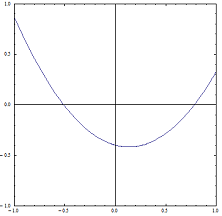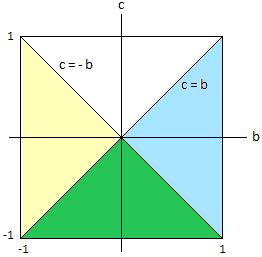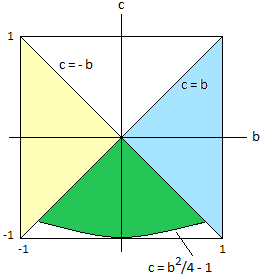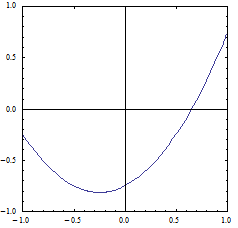 deutsche Version
deutsche Version| Manfred Börgens Mathematical Problems |
problem list previous problem next problem |
main page |
 deutsche Version deutsche Version |
Parabola in a Square
We define the quadratic polynomial f by f(x) = x2 + b.x + c with b,c ∈ R .
Which constants b,c suit the constraint f: [-1,1] → [-1,1] ?
Hence, we are looking for all parabolas f(x) = x2 + b.x + c , whose graph for x ∈ [-1,1] lies completely in the square [-1,1]2 .

|b| ≤ 1 and |c| ≤ 1 are shown easily: f(0)= c yields |c| ≤ 1 ; f(-1)= 1 - b + c ∈ [-1,1] and f(1)= 1 + b + c ∈ [-1,1] yield 2b = f(1)-f(-1)∈ [-2,2] .
The parabolas in question are convex and have a strict absolute minimum. Hence, only two conditions must be considered:
a) Both boundary values of the parabola must lie in [-1,1] . We want to find b and c with f(-1)∈ [-1,1] and f(1)∈ [-1,1] .
b) We shall prove that the minimum of the parabola has the coordinate x = xextr ∈ [-1/2, 1/2] with f'(xextr) = 0 . Hence, the second condition is f(xextr) ∈ [-1,1] .
To a)
We already know |b| ≤ 1 and |c| ≤ 1 .
(1) f(1) ≤ 1 ⇔ 1 + b + c ≤ 1 ⇔ c ≤ -b
(2) f(1) ≥ -1 ⇔ 1 + b + c ≥ -1 . This is always true because b ≥ -1 and c ≥ -1 .
(3) f(-1) ≤ 1 ⇔ 1 - b + c ≤ 1 ⇔ c ≤ b
(4) f(-1) ≥ -1 ⇔ 1 - b + c ≥ -1 . This is always true because b ≤ 1 and c ≥ -1 .
(1) - (4) yield
(5) c ≤ -|b| . This implies c ≤ 0 .

Figure 1
In figure 1 the blue-green region corresponds to c ≤ b , the yellow-green region corresponds to c ≤ -b . The green intersection of the two regions contains all pairs (b,c) with c ≤ -|b| ; for these pairs the boundary values of the parabola lie in [-1,1] .
To b)
Which pairs (b,c) in the green region of figure 1 belong to a parabola with minimum value in [-1,1] ?
The first step is the proof that the absolute minimum of the parabola has the coordinate x = xextr ∈ [-1/2, 1/2] :
f'(x) = 2x + b = 0 ⇔ x = -b/2
xextr = -b/2 ∈ [-1/2, 1/2] and f(xextr) = -b2/4 + c ≤ 0 . (5) implies that the minimum of the graph lies in the lower half of the real plane.
For the pairs (b,c) in the green region in figure 1 the condition f(xextr) ∈ [-1,1] is equivalent to -b2/4 + c ∈ [-1,0] or b2/4 - 1 ≤ c ≤ b2/4 . But c ≤ b2/4 is always true because c ≤ 0 . Hence we get:
(6) c ≥ b2/4 - 1
Which b meet the condition (6) ? Have a look at figure 2. There the graph of c = b2/4 - 1 is the lower border of the green region. This graph does not stretch to b = 1 or b = -1 because c ≤ -|b| (see (5) and the green region in figure 1). This means we have to find the intersections of c = b2/4 - 1 and c = -|b| . For the intersection on the right with b > 0 we get b2/4 - 1 = -b ⇔ b = √8 - 2 . The symmetry of figure 2 gives the result:
(7) |b| ≤ 2(√2 - 1) ≈ 0,8284

Figure 2
We conclude from (5), (6) and (7):
|b| ≤ 2(√2 - 1) c ∈ [b2/4 - 1, -|b|]
The corresponding pairs (b,c) are shown as the green region in figure 2.
Example: For b = 1/2 all c ∈ [-15/16, -1/2] meet the conditions. One of the corresponding parabolas is f(x) = x2 + x/2 - 3/4 whose graph is shown in figure 3.

Figure 3
For a similar problem see Mathematical Excalibur 1/2, problem 6.